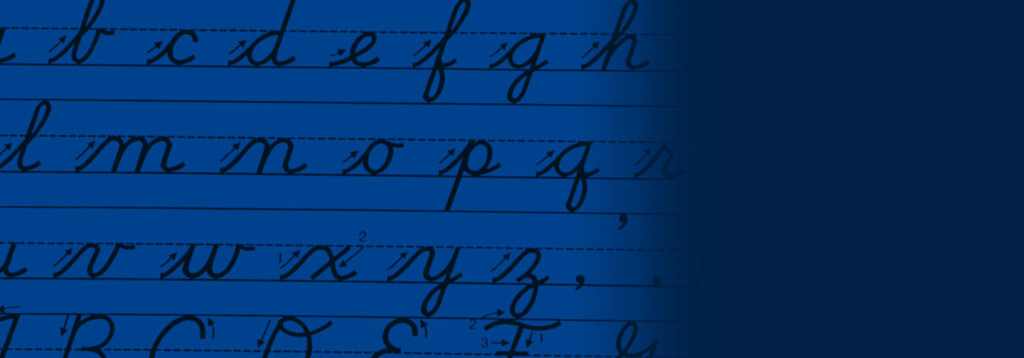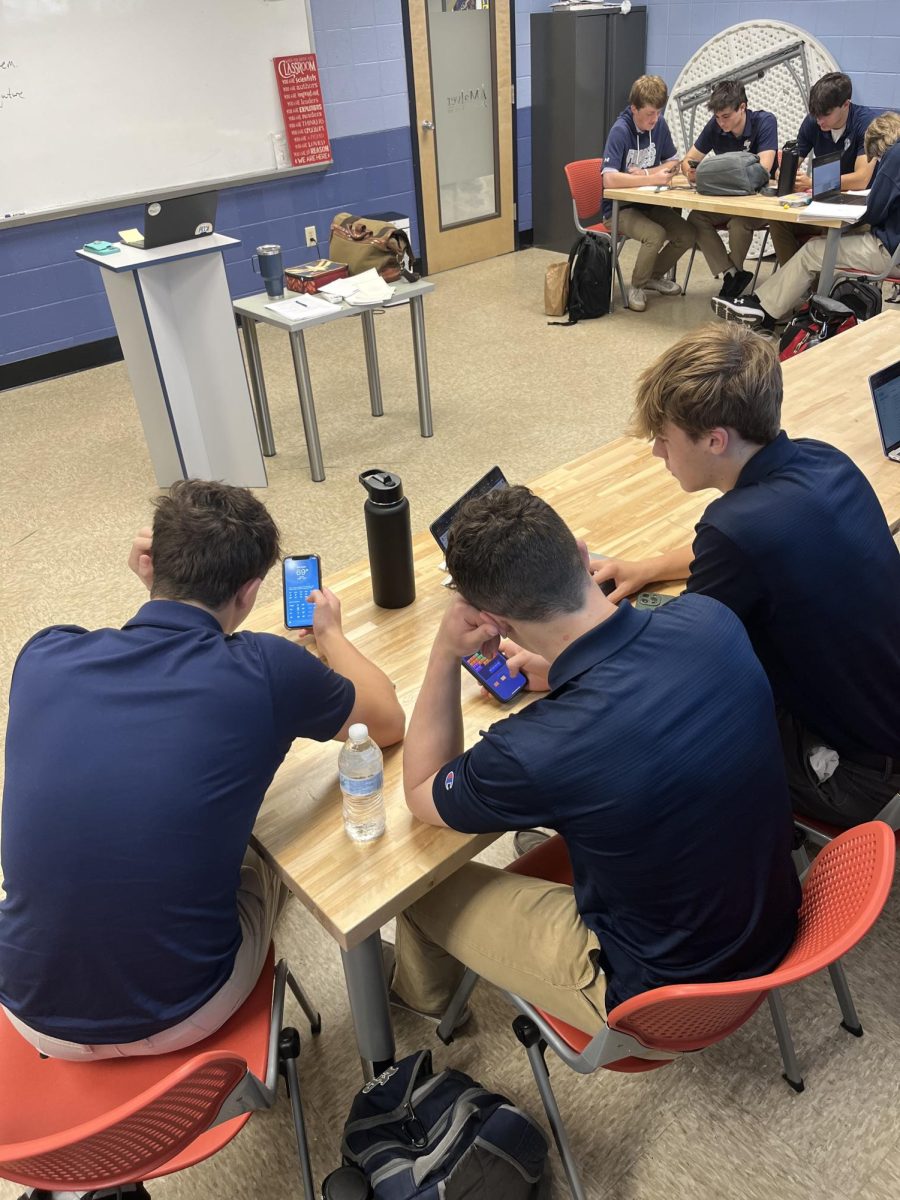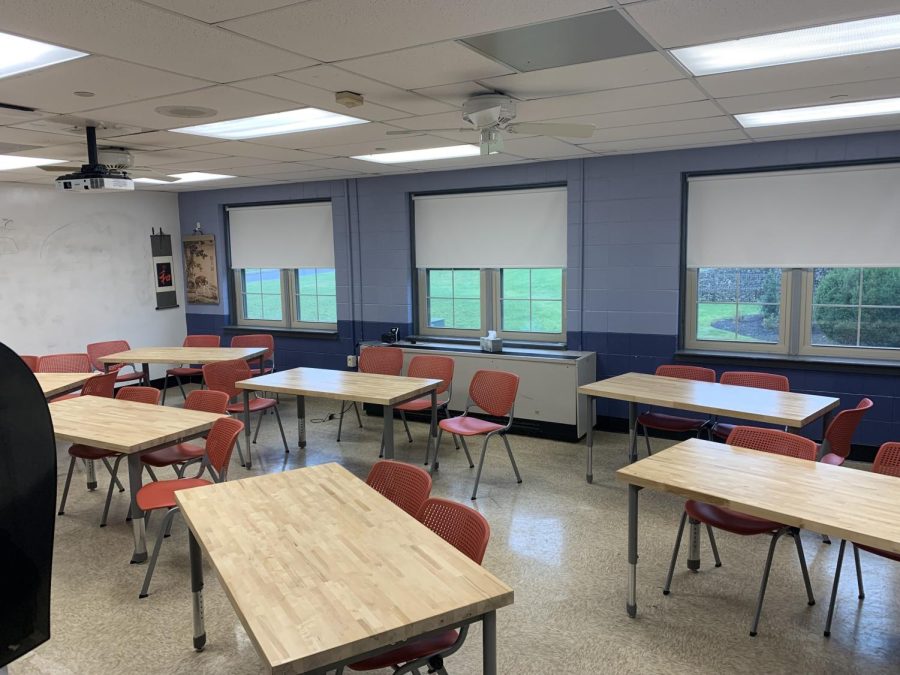 Many of us remember the pain-staking repetition of perfecting those loopy letters and perfect connections. As we get older, are we actually applying that third grade skill anymore?
Many of us remember the pain-staking repetition of perfecting those loopy letters and perfect connections. As we get older, are we actually applying that third grade skill anymore?
If this article was written in cursive, many wouldn’t bat an eye before setting down the paper and playing a game on their brand new iPhone 6. While practicing cursive writing was all the rage ten years ago, today’s elementary school students are way more concerned with Candy Crush.
I personally remember handwriting classes and the 200 page book with endless dotted lines and margins to write thousands of little loopy letters. I picked up the skill in the second grade and mastered it in third. By sixth grade, I couldn’t connect a T to a Y in cursive if I tried. Now, I couldn’t even begin to read it.
In my opinion, cursive writing is obsolete and forevermore will be. This is not so much to reflect on a style of writing but to focus on a new style of communication all together. With the advancement of technology, the average American reads the daily newspaper on an app or on the internet. Information can be relayed to an individual while they are in their PJ’s lying in bed.
It was stated in an April USA Today story that at least 41 schools no longer require public schools to teach cursive reading or writing. Even though some states have started to prioritize computer and typing skills, many schools haven’t come up with a viable replacement skill to teach.
While many high school students are still using the Dewey Decimal System to find their old and heavy research books, Malvern students enjoy a library filled with laptops and iPads which open a pathway to unlimited knowledge.
Just as cursive writing has become obsolete, so has looking up information manually. With the addition of Google, Wikipedia, and various online databases the only books students need for information are Chromebooks.
I would like to see schools across America with a similar setup to Malvern. There is no point in learning a skill with no application in the real world anymore. Students of the 21st century will find themselves more prepared for the business world with a laptop and a smartphone rather than a quill and inkwell.
It is important for schools to continue educating their students on popular trends and advancements. The work they do in school should directly relate to the work they will be doing in the real world. Someone who can write killer cursive essays in Latin has less power than an 11 year old with a Macbook Pro.
Once again this is something that our school really excels in. The buzz word “collaboration” comes up a lot as a joke and an excuse for not doing your own work. However, it will prove to be a very useful tool in the future.
You will never find yourself in a situation in which you won’t have access to the internet to complete your work assignment. The wonderful creation of YouTube can make an average person learn the basics of a completely unknown task in the matter of minutes and a few ads. That is why it is important to be tested on the information you can access rather than the information you know.
Accessing information is a skill, one you will evaluated on when interviewing for a job. You want to be quick on your feet. You must be ready to not only adjust to new trends but embrace them. This is something schools should teach you.
You should be surrounded with constant application of technology. It is what you’ll see in the future and there is no use in being behind the learning curve.
The world is scary and unpredictable. You need to be prepared for everything it throws at you. It is important for students to be technologically active. Today’s video game playing “nerds” will be tomorrow’s computer designing millionaires.
The times are changing and so must our country’s schools. Recently, Alex Rodriguez wrote an apology letter to the fans for his PED usage. Despite his sincere efforts, no one could take him seriously and only joked about him writing a letter in cursive in an age with technology and twitter.
The only time you should be writing in cursive is to sign your name, like on Rodriguez’s new baseball contract.














Kate Gladstone • Feb 27, 2015 at 10:16 pm
Handwriting matters — but does cursive matter? The research is surprising. For instance, it has been documented that legible cursive writing averages no faster than printed handwriting of equal or greater legibility. (Sources for all research are listed below.)
More recently, it has also been documented that cursive does NOT objectively improve the reading, spelling, or language of students who have dyslexia/dysgraphia.
This is what I’d expect from my own experience, by the way. As a handwriting teacher and remediator, I see numerous children, teens, and adults — dyslexic and otherwise — for whom cursive poses even more difficulties than print-writing. (Contrary to myth, reversals in cursive are common — a frequent cursive reversal in my caseload, among dyslexics and others, is “J/f.”)
— According to comparative studies of handwriting speed and legibility in different forms of writing, the fastest, clearest handwriters avoid cursive — although they are not absolute print-writers either. The highest speed and highest legibility in handwriting are attained by those who join only some letters, not all: joining only the most easily joined letter-combinations, leaving the rest unjoined, and using print-like shapes for letters whose printed and cursive shapes disagree.
Reading cursive still matters — but reading cursive is much easier and quicker to master than writing the same way too. Reading cursive, simply reading it, can be taught in just 30 to 60 minutes — even to five- or six-year-olds (including those with dyslexia) once they read ordinary print. (There’s even an iPad app teaching kids and others to read cursive, whether or not they write it or ever will write it. The app — “Read Cursive” — is a free download. Those who are rightly concerned with the vanishing skill of cursive reading may wish to visit appstore.com/readcursive for more information.)
We don’t require our children to learn to make their own pencils (or build their own printing presses) before we teach them how to read and write. Why require them to write cursive before we teach them how to read it? Why not simply teach children to read cursive — along with teaching other vital skills, such as a form of handwriting that is actually typical of effective handwriters?
Just as each and every child deserves to be able to read all kinds of everyday handwriting (including cursive), each and every one of our children — dyslexic or not — deserves to learn the most effective and powerful strategies for high-speed high-legibility handwriting performance.
Teaching material for practical handwriting abounds — especially in the UK and Europe, where such handwriting is taught at least as often as the accident-prone cursive which is venerated by too many North American educators. Some examples, in several cases with student work also shown: http://www.BFHhandwriting.com, http://www.handwritingsuccess.com, http://www.briem.net, http://www.HandwritingThatWorks.com, http://www.italic-handwriting.org, http://www.studioarts.net/calligraphy/italic/curriculum.html )
Even in the USA and Canada, educated adults increasingly quit cursive. In 2012, handwriting teachers across North America were surveyed at a conference hosted by Zaner-Bloser, a publisher of cursive textbooks. Only 37% wrote in cursive; another 8% printed. The majority — 55% — wrote with some elements resembling print-writing, others resembling cursive.
(If you would like to take part in another, ongoing poll of handwriting forms — not hosted by a publisher, and not restricted to teachers — visit http://www.poll.fm/4zac4 for the One-Question Handwriting Survey, created by this author. As with the Zaner-Bloser teacher survey, so far the results show very few purely cursive handwriters — and even fewer purely printed writers. Most handwriting in the real world — 75% of the response totals, so far — consists of print-like letters with occasional joins.)
When even most handwriting teachers do not themselves use cursive, why glorify it?
Believe it or not, some of the adults who themselves write in an occasionally joined but otherwise print-like handwriting tell me that they are teachers who still insist that their students must write in cursive, and/or who still teach their students that all adults habitually and normally write in cursive and always will. (Given the facts on our handwriting today, this is a little like teaching kids that our current president is Richard Nixon.)
What, I wonder, are the educational and psychological effects of teaching, or trying to teach, something that the students can probably see for themselves is no longer a fact?
Cursive’s cheerleaders (with whom I’ve had some stormy debates) sometimes allege that cursive has benefits which justify absolutely anything said or done to promote that form of handwriting. The cheerleaders for cursive repeatedly state (sometimes in sworn testimony before school boards and state legislatures) that cursive cures dyslexia or prevents it, that it makes you pleasant and graceful and intelligent, that it adds brain cells, that it instills proper etiquette and patriotism, or that it confers numerous other blessings which are no more prevalent among cursive users than among the rest of the human race. Some claim research support — citing studies that invariably prove to have been misquoted or otherwise misrepresented by the claimant.
So far, whenever a devotee of cursive claims the support of research, one or more of the following things has become evident as soon as others examined the claimed support:
/1/ either the claim provides no source,
or
/2/ if a source is cited, and anyone checks it out, the source turns out to have been misquoted or incorrectly paraphrased by the person citing it
or
/3/ the claimant correctly quotes/cites a source which itself indulges in either /1/ or /2/.
Cursive devotees’ eagerness to misrepresent research has substantial consequences, as the misrepresentations are commonly made — under oath — in testimony before school districts, state legislatures, and other bodies voting on educational measures. The proposals for cursive are, without exception so far, introduced by legislators or other spokespersons whose misrepresentations (in their own testimony) are later revealed — although investigative reporting of the questionable testimony does not always prevent the bill from passing into law, even when the discoveries include signs of undue influence on the legislators promoting the cursive bill? (Documentation on request: I am willing to be interviewed by anyone who is interested in bringing this serious issue inescapably before the public’s eyes and ears.)
By now, you’re probably wondering: “What about cursive and signatures? Will we still have legally valid signatures if we stop signing our names in cursive?” Brace yourself: in state and federal law, cursive signatures have no special legal validity over any other kind. (Hard to believe? Ask any attorney!)
Questioned document examiners (these are specialists in the identification of signatures, the verification of documents, etc.) inform me that the least forgeable signatures are the plainest. Most cursive signatures are loose scrawls: the rest, if they follow the rules of cursive at all, are fairly complicated: these make a forger’s life easy.
All handwriting, not just cursive, is individual — just as all handwriting involves fine motor skills. That is why any first-grade teacher can immediately identify (from the print-writing on unsigned work) which of 25 or 30 students produced it.
Mandating cursive to preserve handwriting resembles mandating stovepipe hats and crinolines to preserve the art of tailoring.
SOURCES:
Handwriting research on speed and legibility:
/1/ Arthur Dale Jackson. “A Comparison of Speed and Legibility of Manuscript and Cursive Handwriting of Intermediate Grade Pupils.”
Ed. D. Dissertation, University of Arizona, 1970: on-line at http://www.eric.ed.gov/?id=ED056015
/2/ Steve Graham, Virginia Berninger, and Naomi Weintraub. “The Relation between Handwriting Style and Speed and Legibility.” JOURNAL OF EDUCATIONAL RESEARCH, Vol. 91, No. 5 (May – June, 1998), pp. 290-296: on-line at http://www.jstor.org/stable/pdfplus/27542168.pdf
/3/ Steve Graham, Virginia Berninger, Naomi Weintraub, and William Schafer. “Development of Handwriting Speed and Legibility in Grades 1-9.”
JOURNAL OF EDUCATIONAL RESEARCH, Vol. 92, No. 1 (September – October, 1998), pp. 42-52: on-line at http://www.jstor.org/stable/pdfplus/27542188.pdf
Zaner-Bloser handwriting survey: Results on-line at http://www.hw21summit.com/media/zb/hw21/files/H2937N_post_event_stats.pdf
Ongoing handwriting poll: http://poll.fm/4zac4
The research most often misrepresented by devotees of cursive (“Neural Correlates of Handwriting” by Dr. Karin Harman-James at Indiana University):
https://www.hw21summit.com/research-harman-james
Background on our handwriting, past and present:
3 videos, by a colleague, show why cursive is NOT a sacrament:
A BRIEF HISTORY OF CURSIVE —
http://youtu.be/3kmJc3BCu5g
TIPS TO FIX HANDWRITING —
http://youtu.be/s_F7FqCe6To
HANDWRITING AND MOTOR MEMORY
(shows how to develop fine motor skills WITHOUT cursive) —
http://youtu.be/Od7PGzEHbu0
Yours for better letters,
Kate Gladstone
DIRECTOR, the World Handwriting Contest
CEO, Handwriting Repair/Handwriting That Works
http://www.HandwritingThatWorks.com
[email protected]